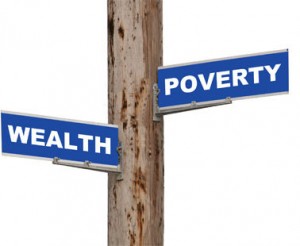LatinaLista — In the ongoing battle in Washington DC over cuts in spending, a popular sentiment politicians like to invoke is the notion that all Americans have to do is work hard to achieve the American Dream. Of course, it depends on which side of the aisle is using it — one side doesn’t feel certain Americans are working hard enough and just want entitlement programs to skip through life and the other side feels certain Americans aren’t given equal chances to achieve the American Dream.
Well a new study, “The Roots of the Widening Racial Wealth Gap: Explaining the Black-White Economic Divide,” by the Institute on Assets and Social Policy (IASP) at Brandeis University underscores how for certain people the opportunity to attain the American Dream is more mirage than reality.
For a quarter of a century (1984-2009), the study’s researchers followed the same nearly 1,700 working-age white and African American households. They found “the wealth gap almost tripled from 1984 to 2009, increasing from $85,000 to $236,500. The median net worth of white households in the study has grown to $265,000 over the 25-year period compared with just $28,500 for the black households.”
Though the study only focused on blacks and whites, the five “fundamental factors” that were identified by the study’s authors that contributed and still contribute to such a stunning wealth gap easily apply to Latinos as well. The five factors are:
The number of years of home ownership; average family income; employment stability, particularly through the Great Recession; college education, and family financial support and inheritance.
Unfortunately, the majority of Latino families share in these fundamental factors making Latinos also on the losing end of the wage gap. Yet, as the study’s authors point out, the main reasons why these families-of-color are so negatively impacted by the same factors that advance white households into securing the American Dream without a loss to their wealth are because of government and institutional policies.
“In the context of the social sciences, whenever you can isolate the factors that really explain what’s happening, that’s a huge step forward,” said Dr. Thomas Shapiro, the director of the IASP and a principal author of the report. “And what these particular factors provide is compelling evidence that various government and institutional policies that shape where we live, where we learn and where we work propel the large majority of the widening racial wealth gap.”
A prime example that not all things are equal is in the housing sector.
“The report shows in stark terms that it’s not just the last recession and implosion of the housing market that contributed to widening racial wealth disparities,” noted Anne Price, director of the Closing the Racial Wealth Gap Initiative at the Insight Center for Community Economic Development. “Past policies of exclusion, such as discriminatory mortgage lending, which continues today, ensure that certain groups reap a greater share of all America has to offer while others are left out.”
According to the authors, the only way to shrink this wealth gap is to institute the very things conservatives railed against in Obama’s State of the Union address: raise the minimum wage, enforce equal pay, invest in high-quality early childhood education and “overhaul preferential tax treatments for dividend and interest income and the home mortgage deduction.”
“All families need a financial cushion to be economically secure and create opportunities for the next generation,” said Dr. Shapiro. “Wealth – what we own minus what we owe – allows families to move forward by moving to better and safer neighborhoods, investing in businesses, saving for retirement and supporting their children’s college aspirations. Our economy cannot sustain its growth in the face of this type of extreme wealth inequality.”





